Submitted by Anju George
Multiculturalism: Shaping sites of encounter across diverse populations
Canada Architecture News - Oct 16, 2022 - 10:50 5124 views

Guests make their way to the heart garden planting during the Truth and Reconciliation Commission’s closing ceremonies. Image © Sean Kilpatrick, The Canadian Press
Introduction
With countries like Canada at the helm of affairs surrounding multiculturalism and diversity, it is important for us planners to not just scratch the surface, but to dig deep down and unravel what is beneath the shiny ‘multicultural’ surface to understand what is really going on. As Koul states, “And while Canada purports to be multicultural, Toronto in particular, a place where everyone is holding hands and cops are handing out ice cream cones instead of, say, shooting black men, our inability to talk about race and its complexities actually means our racism is arguably more insidious”1. Is this how Canada is perceived by many others as well or are they just pulling back the curtain that is hiding its racist past (and present)? Maynard also speaks to this myth of multiculturalism, and the supposed tenets of progression, tolerance and inclusion that have cast a shadow over the inherent racism of Canada’s past (and present), in her seminal book on policing Black lives2. The onus is on us planners to change that rhetoric and steer the ship towards making equitable, multicultural communities in Canada.
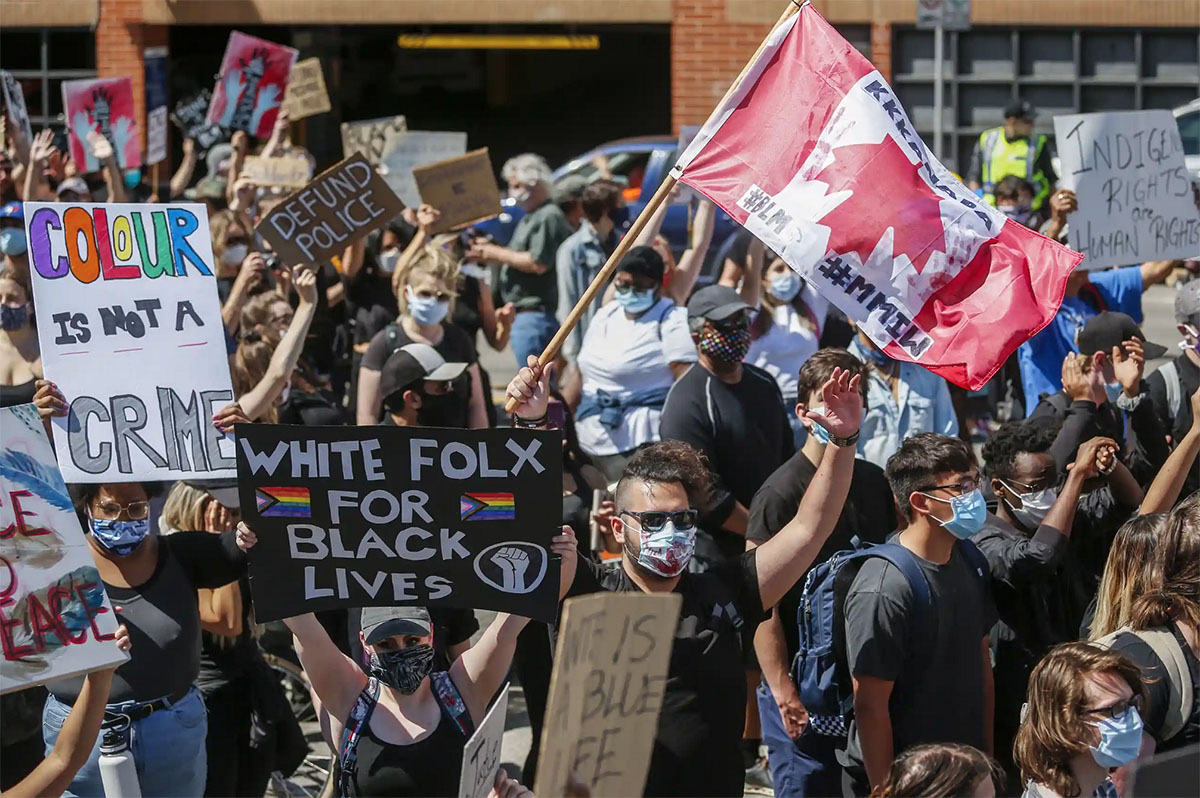
Protesters in Calgary rallying against police brutality. Image © Jeff McIntosh/The Associated Press via The Guardian
The questions that demand answers are too many. Is Canada truly multicultural in every sense of the word or is it just a façade for the world to see? Is there a growing mismatch between the expectations of the actual planning world in a market-based economy and that of the culturally competent planner who plans for the masses? Where do we as planners stand in these debates? Are we (planners) steering the dialogue on multiculturalism or furthering the injustices brought about by corporate planning firms? Are we merely voiceless spectators at organizations that plan for a select few? Are we tokenistic props that planning commissions hire to appease the disenfranchised few in a crowd? Porter’s rant in the paper resonated with me in more ways than one3. As planners, we need to be angry. We cannot afford to be silent anymore as being silent is almost always as bad as inflicting harm. Grave injustices are being committed and we ought to be held accountable. For as Porter said, “What a galling and repugnant silence, given our supposed interest in placemaking and sustainable futures”4.
But, before we get into the meat of this article, we would have to revisit the ideas surrounding what multiculturalism entails and on what it actually means to be multicultural. Multiculturalism, as Fincher et al. note, is a melange of a demographic reality in light of immigration, a kind of policy framework which some governmental authorities have laid out as a reactionary measure, and a philosophy mobilized by various actors to legitimize their political claims in the arena5. With planning scholars researching the aforementioned, and planning practitioners implementing so called just city outcomes, it has been established that multiculturalism is, in fact, both contested and ambiguous. As Sandercock suggests in her book, Cosmopolis II, would it help to understand planning histories, revisit and reconstruct them6? After all, the histories that are conveyed to us are those that belong to the White colonialists7. Cities, as ‘cities of difference’, bring forth implications for urban planning and citizenship, where planning histories can be reconstructed to reflect the injustices meted out to the disenfranchised ethnic minorities8. Understanding these ‘new’ planning histories can help us planners initiate the dialogue on equitable change and design the future of cities to allow for diverse groups to engage.
As much as we differentiate between different ethnic identities, we need to also recognize that there are differences between homogeneous ethnic identities. Sutama Ghosh writes about the problems associated with establishing ‘race’ as synonymous with ‘culture’ and ‘place’, and claims that the process is inherently racist in nature9. She focuses her research on the supposed homogeneous South Asian identity, as perceived by others.
Because in doing so, important historical, linguistic, religious and political diversities are ignored, while a similarity of phenotypical features is highlighted. Moreover, once people are categorised and labelled racially, these categories are widely circulated and imposed institutionally, leaving little power in the hands of those objectified to challenge or attempt to change these systems10.
These are the conversations planners need to have in planning schools and planning practice. If we as planners are not aware of the problems associated with multiculturalistic or pluralistic planning in the background or the nuances in planning discourse, how can we plan to adopt equitable processes that result in just outcomes? A goals-based approach or an outcomes-based approach to multiculturalism would need to include the voices of the marginalized and the disempowered. In such situations, the need for cultural competence cannot be reiterated enough.
The demographic of Canada has been changing over decades and continues to do so as we speak. The arrival of immigrant communities is one of the major reasons for this demographic transformation. As planners, we have to be able to accommodate ethnic (and other) difference and recognize diversity through the implementation of planning interventions.
Multicultural sites: Spaces of belonging and collaboration
Sites may not be viewed solely as physical entities, but places that can become avenues of cultural exchange. As a trained Architect in my past life and an Urban Planner in this one, this piece is to understand both how built structures have the ability to influence space, and how these man-made physical spaces can potentially transform into sites of encounter and engagement.
Sites of encounter are diverse, ranging from those that are transient such as festival spaces to those that are permanent like community centres. As much as multicultural festivals are sites that encourage belonging and situate localness, they celebrate diversity beyond that of the locally defined community. The structure of the local festival provides a platform for collaborative dialogue. Within the framework of multiculturalism, the interest is ascribed to what diverse peoples are doing regarding identity and belonging. These actions often bypass the local government’s efforts to manage cultural difference through its implementation of multicultural policies11.
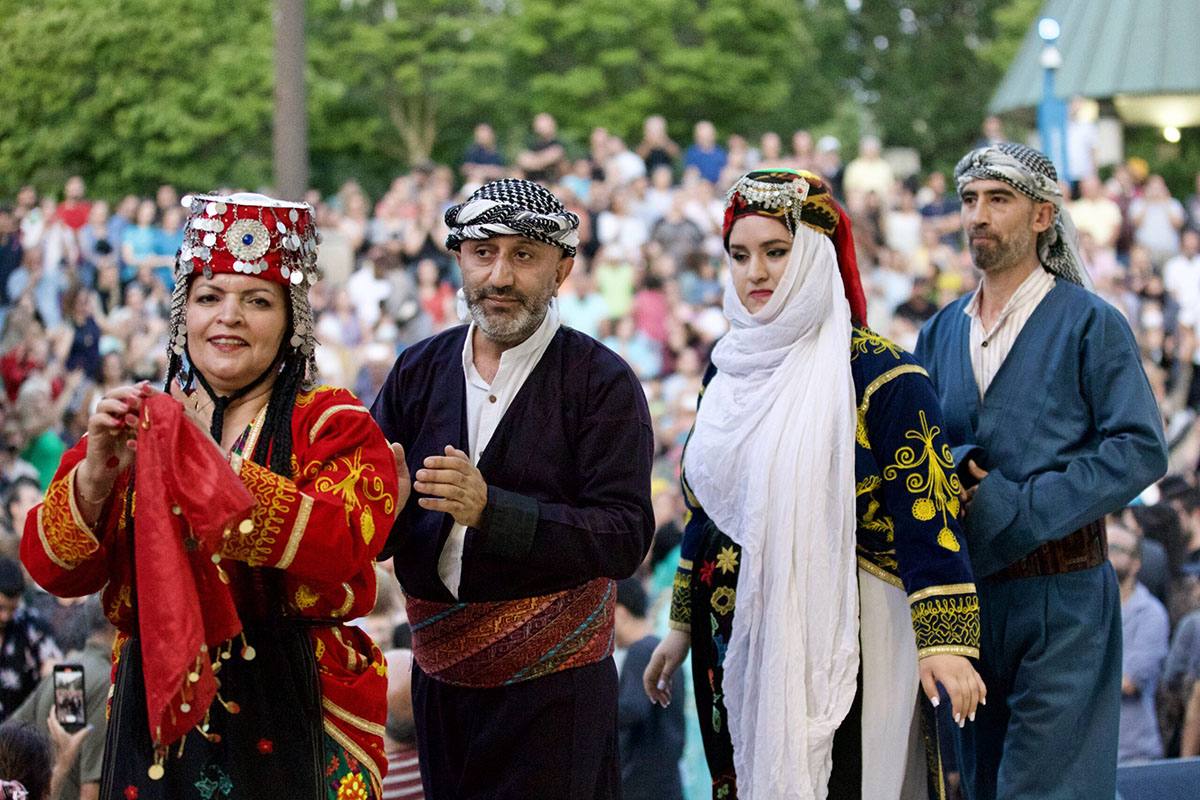
Kurdish dancers showcase figures and traditional outfits at the Kurdish Cultural Festival in Toronto. Image © Nur Dogan, New Canadian Media
Ash Amin discusses the importance afforded to situational sites of intervention12.
There is no formula here other than perhaps the engineering of endless talk and interaction between adversaries or provision for individuals to broaden horizons, because any intervention needs to work through, and is only meaningful in, a situated social dynamic13.
Identities are known to be socially constructed, and therefore the construction of community identity in both the case studies reflect a certain tension regarding its fluid, multilayered and dynamic nature14.
Case Study I: Toronto’s Caribbean Caribana Festival
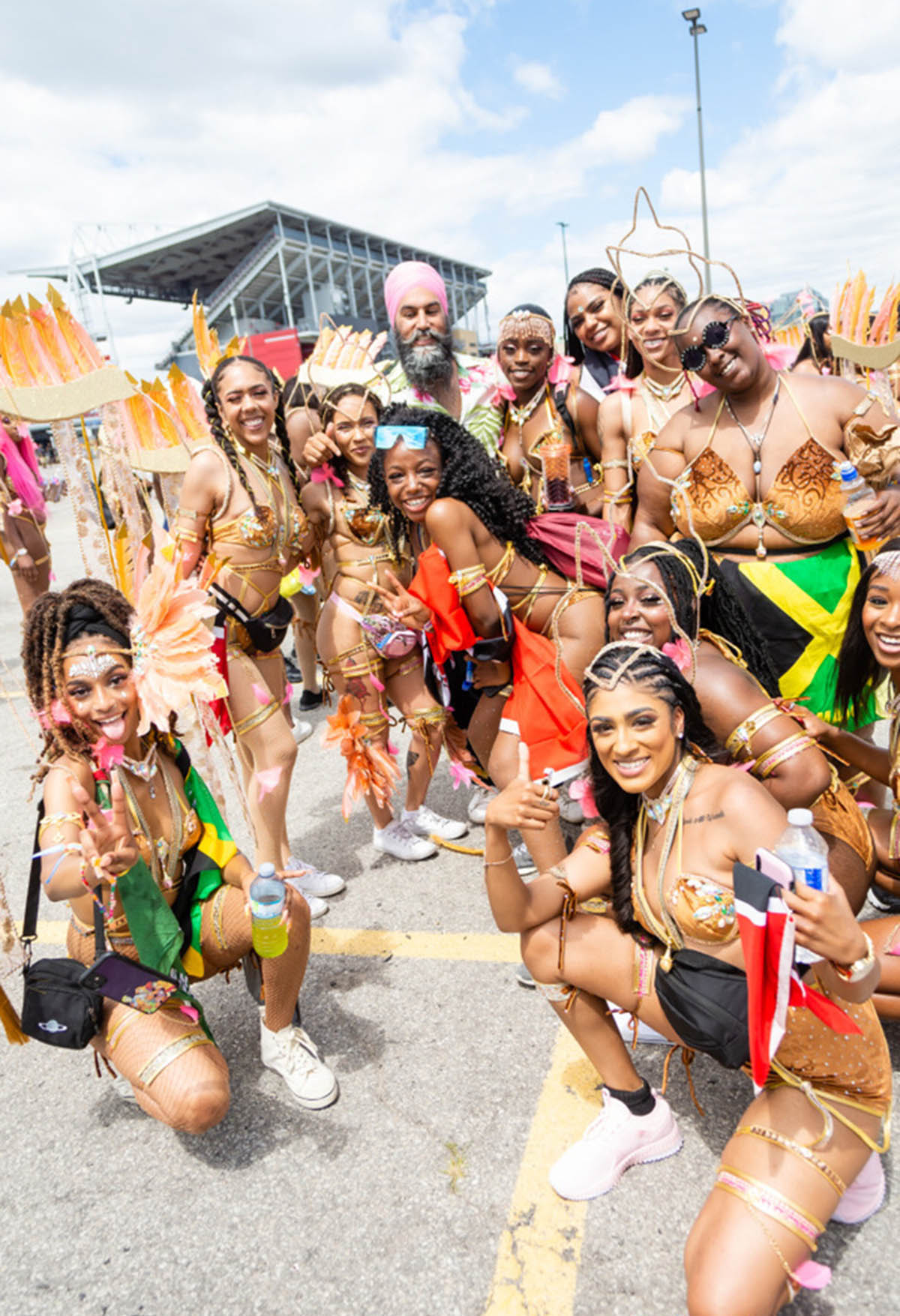
Grand Parade after a two year COVID hiatus in Toronto. Image © CaribanaToronto.com
Festivals are often regarded as avenues of celebration of communities that are marginalized in the wider public realm15. Toronto’s Caribbean Caribana Festival, which was held in the end of August, is emblematic of this very characteristic, and commemorates the emancipation of slaves from their colonizers in the Caribbean region. For the said reasons, a festival is a flagship of the municipal governments’ initiatives to promote multiculturalism, thereby hoping to develop greater tolerance of ethnic minority communities16.
The image of the city portrayed in the festival looms large and is central to how the city is perceived. People, places and activities that are not in alignment with the ‘desired image’ are thereby excluded consequentially17. Some critics have positioned multicultural festivals to be providers of opportunities that demonstrate the value of minority ethnic groups’ culture to the White ‘host’ culture18.
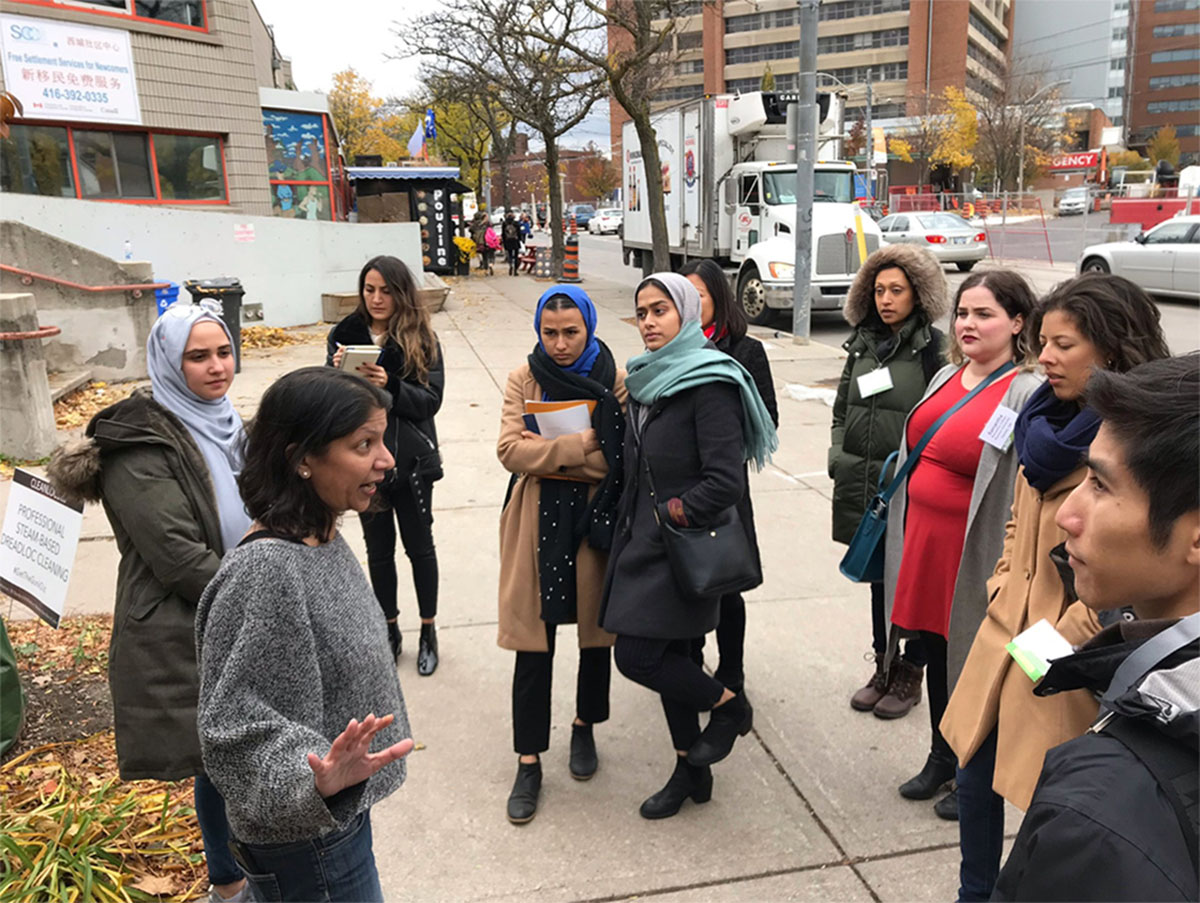
Alina Chatterjee speaking about Scadding Court Community Centre's innovative programs that create opportunities and inclusion for residents in Toronto. Image © Alissa Randall / Infomart via ULI Toronto.
The spaces of encounter discussed here foster a social cohesion, which is an attribute of the quality of the social bonds and of the quality of the institutions. As the communities that house these very sites, these spaces are not meant to counter diversity and pigeonhole categorizations of identities, but to build institutions that can promote civil, economic and political rights that provide individuals and (ethnic) communities the leverage to fulfill their full potential19.
While planners and planning scholars alike may not agree on one particular definition of multiculturalism, advocates of different forms of multiculturalism believe in the transformative potential of encounter. The interactions between ethnic communities, which can take place within the sphere of multiculturalism, are hoped to reduce prejudice (racial, ethnic and other) and social conflict20. Encounters may or may not always be pleasant and life changing; all the same, planners need to invest their efforts into creating spaces that can initiate consultation and encourage debate. Encounters provide the opportunity to stimulate discussion.
Case Study II: A wedding that left an indelible mark
My friend wanted me to be a part of her big day and I knew I wanted to be there for her because she meant the absolute world to me. Her wedding was certainly special to me. The reasons that made this wedding unique was that it was my first gay White wedding. I did not know what to expect in the least. A series of questions came over me. Would a priest be involved? Was it even legal for same-sex couples to be married? Were my friend’s family and friends open to their union? Back in India, where I come from, these subjects are taboo, not because gays do not exist, but because these unions are frowned upon as they are considered primarily unnatural.
I learnt of distinct customs and traditions at this wedding. The list began to seem endless. Indian weddings are usually extremely lengthy, spread over a week or so, and the guest list is unnecessarily long (500 guests minimum). You have brothers of husbands of sisters, you have neighbours who have crossed paths with you when you lived in a neighbourhood for all of two months, and you have the loathed Aunty whom you have to call out of sheer respect. But here, at this wedding, there were all of 80 to a 100 people. Just close family and friends.
At Indian weddings, there are many a times when rude glances and long, hard stares are exchanged, for reasons pertaining to our singlehood at an advanced age, for our dressing choices or even for the persons we choose to spend our lives with, but here everybody seemed open and welcoming of our choices. So many of the guests came up to us, who happened to be the only Indians at this wedding, and asked us about our ethnicity, and our choice of attire (wore Punjabi attire). Another thing that stood out was the utter absence of any religious customs or rituals. All the other weddings I attended had a strong religious component. The fact that this was a gay wedding was probably why religion was non-existent. The minister who officiated the wedding ceremony was a close friend of the couple’s. She applied for the licence to marry them. Again, this was a first for me. As a wedding guest, I had gone to a few churches and temples, and had even stood outside a mosque because females were not permitted to enter. I had never witnessed a ceremony that did not have a religious person.
What did it mean to be different, especially when it came to a friend whose sexual orientation was different from my own? Engaging with people of different ethnicities and origins, and different sexual orientations in a celebratory atmosphere kindled something in me, that of feeling strange and familiar at the very same time.
I did sense that the wedding would be largely White. In fact, it very much was. There were just two other Asians at the wedding. As much as monochromatic crowds infuriate me, this was weirdly comforting. Had it been an Indian gay wedding, the reception would have been far from welcoming. When I told my Indian friends here that I was visiting the US to attend a gay wedding, they expressed shock. As an Indian, most of them assumed that I was going to attend an Indian wedding. When I told them that it was a gay wedding, their shock grew stronger. Their feelings were strangely not out of place though. I would have had the same feelings if I heard the same from a friend. These feelings did not necessarily stem out of hatred, but in fact, stemmed from an acknowledgement that the people of India have a long way to go in terms of being open to things that are socially perceived as wrong. India still does not recognize same-sex unions. In the eyes of the law, same-sex unions are influenced by Western cultures. Western and Indian contexts are apparently poles apart; one cannot be simply imported into the other21.
Even though my prejudices were not explicit, I might have had inner prejudices that I was not aware of myself. This wedding helped me break those ugly barriers (however unconscious they were) and come to terms with what it would mean to engender friendly spaces where the LGBTQ2S+ crowd felt welcome.
Agyeman and Erickson have articulated such a compelling argument, with far-reaching implications, that need to be understood by practicing planners and planning educators alike22.
Planning educators have a duty to both diversify the profession in terms of race, ethnicity, and other forms of difference, and to help student planners become more aware of (inter) cultural dynamics and how their own conscious and unconscious assumptions, beliefs, knowledge, and desires affect their ability to listen well and understand other cultures.
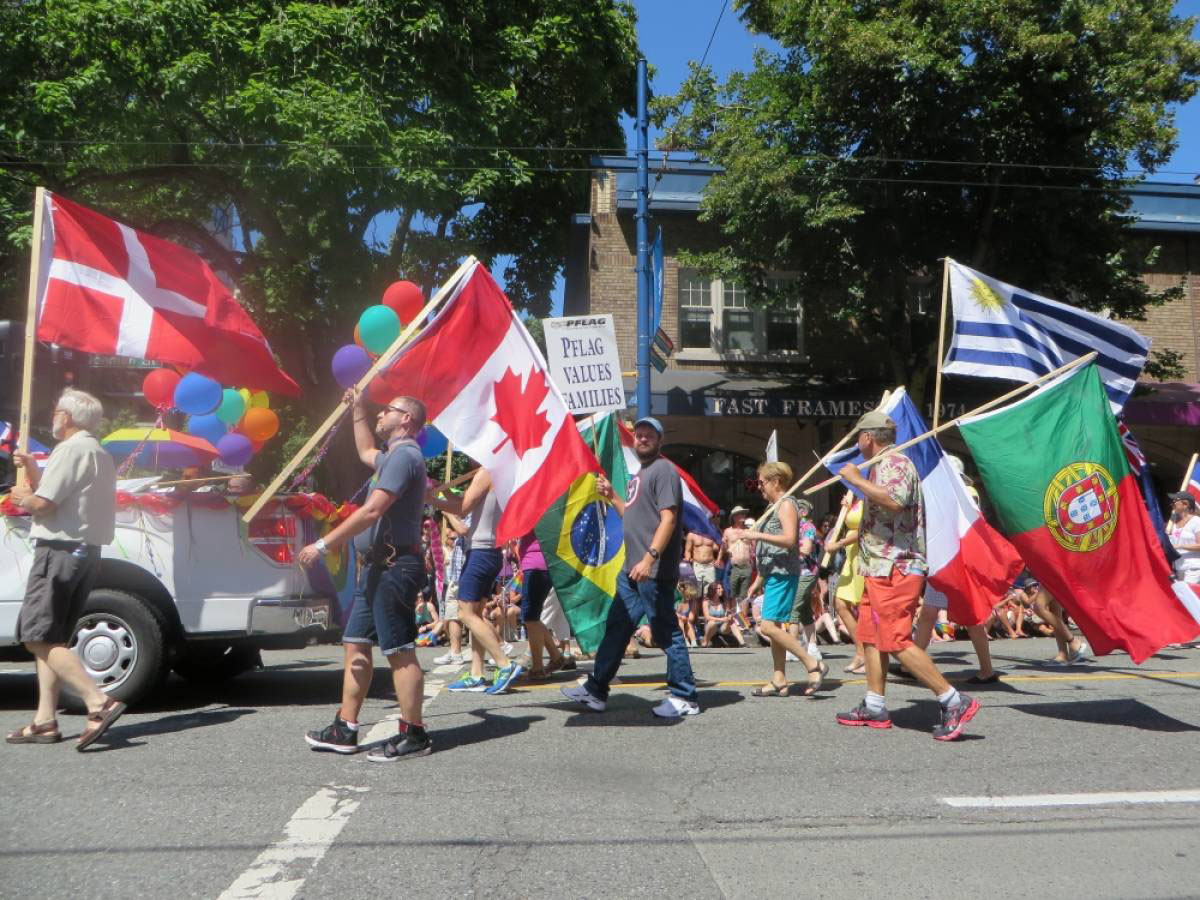
Vancouver celebrates its multicultural society at the Pride parade. Image © Craig Takeuchi/The Georgia Straight
Conclusion: Culturally competent planning towards multicultural futures
Planning with difference, acknowledging diversity and enhancing social cohesion are some of the steps that Burayidi roots for in the planning environment23. As planning researchers aiming to create equitable multicultural communities, we can contribute to a change in public policy that can help the preservation of such ‘zones of encounter’, where both fleeting and planned encounters can serve as important sites of learning to live with deep difference24. The urban public realm is considered both a material and physical space wherein encounters across difference occur. This space can also be utilized as a political forum where “claims concerning the nature and possibilities of that lived difference are articulated”25.

Lunch sampling at the New Canadians Centre's weeklong inaugural Canadian Multiculturalism Festival in Peterborough. Image © Clifford Skarstedt, Examiner.
Several pieces in Burayidi’s book speak to an innate desire of moving away from the current status quo of planning in a multicultural realm, to one of fostering cultural competency in urban planning practice and education alike26. Sen, et al., also in Burayidi’s book, discuss the power of historically Black colleges and universities (HBCUs) in embracing multiculturalism by focusing on difference as key to producing culturally competent planners27. Agyeman and Erickson’s piece speaks to the differences between the ideals brought about by multiculturalism and interculturalism, and champions the need for an intercultural approach to be furthered28. They believe that an intercultural approach in planning education would give birth to culturally competent planners, who celebrate difference in all its forms, and perceive non-consensus to be a stepping-stone for the creation of essentially diverse communities.
Can I now call myself a culturally competent planner because I went to one wedding that was vastly different from the ones I had attended before? Absolutely not! I have far more to learn. All the same, I believe I have become all the more empathetic to the lives led by LGBTQ2S+ in this world. We often times choose to ignore their plight; we honestly believe that their problems are not as acute as they are put out to be. There are countries like my own that detest and criminalize their very being because of the way that they are. The stories of Adhila Nasreen and Fathima Noora are fresh in my memory; they were issued death threats by members of their own family because they chose to live as soulmates29.
As Kiri Crossland, a Transport Planner in New Zealand rightly said, “Genuine communication with queer communities will enable planners to put specific measures in place to support queer people in a way that is appropriate to their local context"30. It is up to us planners to see that we can foster a sense of belonging for all members of the community. As planners, we need to take that first step in making them feel welcome. They can then muster enough courage to lay claim to the city they always felt distanced from. We need to be able to give them the power to choose for themselves without feeling threatened or judged. Addressing planning issues by making public spaces safer and more inclusive for the LGBTQ2S+ community would end up benefitting all sections of the community. There has always been a public hostility towards members of this community; planners have the potential to change those negative perceptions and attitudes.
Tolerance is not always enough; cultural competence is the key to recognize, appreciate and celebrate difference. How can we effectuate change by making those inclusive environments a reality? We may be jumping into the abyss, but let us make informed decisions and include everybody while making them, so that everyone can reap the benefits. Let us not divide further; let us planners be the beacons of hope for the people we serve. Let the fear of the other not scare us. Let us take a moment to think again and fight for what is right for everyone involved. As planners, we should want to take these journeys to acknowledge and understand what it means to be different, to recognize the other and to be perfectly okay with the unknown.
Cultural competency in planning can hopefully become the status quo of how future planners operate. Recognition (and not just acknowledgement) of difference and an appreciation of culture would need to be introduced in planning academia, where academicians are entrusted with diversifying the profession in terms of race and ethnicity, and helping student planners of all backgrounds to become socially aware of different cultural dynamics that informs their decision making abilities. The phenomenon of cultural competency needs to be ultimately about increasing equality in spheres of growing difference31. Umemoto, in response to growing diversity, speaks of a renewed way of practicing planning; a culture-based planning that addresses differences in epistemology among culturally defined groups32. Her viewpoints and perspectives are especially important in the world today because communities are not heterogeneous based on race, ethnicity and gender alone, they differ according to “socially constructed” cultures and identities33.
Let me end this piece with the words of a pioneer of multicultural communities who wants us planners to imagine an inclusive multicultural future. I started off with Porter’s rant and am ending with Sandercock’s hope.
I dream of a city of bread and festivals, where those who don't have the bread aren't excluded from the carnival. I dream of a city in which action grows out of knowledge and understanding; …; where we don't exist for the city but are seduced by it; where only after consultation with local folks could decisions be made about our neighbourhoods; where scarcity does not build a barb-wire fence around carefully guarded inequalities; where I don't have to translate my 'expertise' into jargon to impress officials and confuse citizens34.
References
1. Koul, S. (2017). One Day We'll All Be Dead and None of This Will Matter. Doubleday Canada.
2. Maynard, R. (2017). Policing Black Lives: State Violence in Canada from Slavery to the Present. Halifax: Fernwood Publishing.
3. Porter, L., Roy, A., & Legacy, C. (2021). Planning Solidarity? From Silence to Refusal. Planning Theory & Practice, 22(1), 111-138.
4. Ibid.
5. Fincher, R., Iveson, K., Leitner, H., & Preston, V. (2014). Planning in the multicultural city: Celebrating diversity or reinforcing difference?. Progress in Planning, 92, 1-55.
6. Sandercock, L. (2003). Cosmopolis II: Mongrel Cities of the 21st Century. London:
Bloomsbury. Chapter 2.
7. Ibid.
8. Sandercock, L. (2000). Cities of (In)Difference and the Challenge for Planning. DisP -The Planning Review, 36(140), 7-15.
9. Ghosh, S. (2013). ‘Am I a South Asian, really?’ Constructing ‘South Asians’ in Canada and being South Asian in Toronto. South Asian Diaspora, 5(1), 35-55.
10. Ibid.
11. Permezel, & Duffy, M. (2007). Negotiating the Geographies of Cultural Difference in Local Communities: Two Examples from Suburban Melbourne. Geographical Research, 45(4), 358-375.
12. Amin, A. (2002). Ethnicity and the multicultural city: Living with diversity. Environment and Planning A, 34, 959-980.
13. Ibid.
14. Mouffe, C. (1995). Democracy and pluralism: a critique of the rationalist approach. Cardozo Law Review, 16(5), 1533-1545.
15. Fincher, R., Iveson, K., Leitner, H., & Preston, V. (2014). Planning in the multicultural city: Celebrating diversity or reinforcing difference?. Progress in Planning, 92, 1-55.
16. Ibid.
17. Ibid.
18. Hage, G. (1998). White nation: Fantasies of White supremacy in a multicultural society. Annandale: Pluto Press.
19. Qadeer, M., & Agrawal, S. (2006). Ethnic Enclaves and Social Cohesion. Canadian Journal of Urban Research, 15(2), 1-17.
20. Fincher, R., Iveson, K., Leitner, H., & Preston, V. (2014). Planning in the multicultural city: Celebrating diversity or reinforcing difference?. Progress in Planning, 92, 1-55.
21. Desai, R. (2021, February 25). Marriage a ‘Solemn Institution Between a Biological Man and a Biological Woman,’ Centre Says in Affidavit Opposing Same‑Sex Marriage Petitions. The Swaddle. https://theswaddle.com/marriage-a-solemn-institution-between-a-biological-man-and-a-biological-woman-centre-says-in-affidavit-opposing-same-sex-marriage-petitions/
22. Agyeman, J., & Erickson, J. S. (2012). Culture, recognition, and the negotiation of difference: Some thoughts on cultural competency in planning education. Journal of Planning Education and Research, 32(3), 358-366.
23. Burayidi, M. A. (2015). Moving the Diversity Agenda Forward. In M. A. Burayidi (Ed.), Cities and the Politics of Difference: Multiculturalism and Diversity in Urban Planning (pp. 388-406). University of Toronto Press.
24. Wood, P., & Landry, C. (2008). The intercultural city: Planning for diversity advantage. London: Earthscan.
25. Fincher, R., Iveson, K., Leitner, H., & Preston, V. (2014). Planning in the multicultural city: Celebrating diversity or reinforcing difference?. Progress in Planning, 92, 1-55.
26. Burayidi, M. A. (2015). Moving the Diversity Agenda Forward. In M. A. Burayidi (Ed.), Cities and the Politics of Difference: Multiculturalism and Diversity in Urban Planning (pp. 388-406). University of Toronto Press.
27. Sen, S., Kumar, M., &, Smith, S. L. (2015). Educating Planners for a Cosmopolitan Society: A Selective Case Study of Historically Black Colleges and Universities. In M. A. Burayidi (Ed.), Cities and the Politics of Difference: Multiculturalism and Diversity in Urban Planning (pp. 362–387). University of Toronto Press.
28. Agyeman, J., & Erickson, J. S. (2012). Culture, recognition, and the negotiation of difference: Some thoughts on cultural competency in planning education. Journal of Planning Education and Research, 32(3), 358-366.
29. PTI. (2022, May 31). Kerala High Court reunites lesbian couple separated by parents. The Economic Times. https://economictimes.indiatimes.com/news/india/kerala-high-court-reunites-lesbian-couple-separated-by-parents/articleshow/91924106.cms
30. Crossland, K. (2021, August 19). Sex(uality) in the city: Planning for queerer public space. MRCagney. https://www.mrcagney.com/about/blog/sexuality-in-the-city-planning-for-queerer-public-space/
31. Agyeman, J., & Erickson, J. S. (2012). Culture, recognition, and the negotiation of difference: Some thoughts on cultural competency in planning education. Journal of Planning Education and Research, 32(3), 358-366.
32. Umemoto, K. (2001). Walking in Another’s Shoes Epistemological Challenges in Participatory Planning. Journal of Planning Education and Research, 21(1), 17-31.
33. Ibid.
34. Sandercock, L. (2003). Cosmopolis II: Mongrel Cities of the 21st Century. London: Bloomsbury. Chapter 9.
cities encounters Multiculturalism place populations public space
